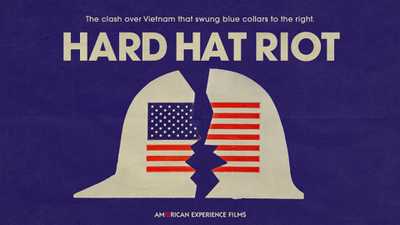How to Cover up a Coup
To understand the erasure of a landmark event in our nation’s history, look to the books

Schoolchildren are a captive audience, and in the pre-internet era, textbooks were unmatched in shaping their view of history. For millions of students passing through North Carolina’s public schools, learning from textbooks that never mentioned the deadly 1898 coup d’etat in their state, it was as though that event never happened. “I took several courses on North Carolina history throughout my middle school and high school career,” Dr. Crystal Sanders, today a history professor at Emory University, told American Experience. “And I never recall hearing about the Wilmington Insurrection.”

A brief summary of what actually did take place: In the 1890s, North Carolina’s Democratic Party—made up of businessmen, former Confederates, and wealthy planters—resented the success of their political opponents, so-called Fusionists. The biracial Fusion coalition consisted of Republicans (at the time, the party of Abraham Lincoln, and so also of Black voters) and Populists, supported by small, struggling white farmers.
In 1898, the Democrats orchestrated an overtly white supremacist campaign to drive Fusion candidates out of office. They also recruited a paramilitary unit called the Red Shirts to terrorize any Black voters that tried to go to the polls. As a result, Democrats swept the November 1898 election. But a racist mob took things further, attacking and killing African Americans in North Carolina’s largest city, Wilmington. White supremacists drove remaining local Fusion officials, often at gunpoint, out of office. It was the only successful overthrow of an elected domestic government in U.S. history.

For years to follow, textbooks omitted the murders and coup entirely. A concerted campaign by a triumvirate of Confederate heritage organizations ensured that they never entered the official record—using textbooks as their primary tool. In the early 20th century, the United Daughters of the Confederacy (UDC), United Confederate Veterans, and Sons of Confederate Veterans banded together, installing their members on state textbook commissions, aggressively pursuing book bans, and persecuting teachers who deviated from the groups’ white supremacist positions. At the UDC’s annual convention in 1905, its president was clear about the group’s pedagogical goals. “It has ever been the cherished purpose of the Daughters of the Confederacy to secure greater educational opportunities for Confederate children, and by thorough training of their powers of mind, heart and hand, render it possible for these representatives of our Southern race to retain for that race its supremacy in its own land.”
By the 1930s, the UDC’s authority had diminished, but segregationist politicians continued the work of suppressing textbooks’ contents. Mentions of the events of 1898, when they were included, consisted of highly manipulated accounts that used the term “race riot,” and blamed African Americans for the violence. The result of more than a century of this deliberate censorship was that as late as 2006, a major publisher’s textbook taught in classrooms, North Carolina: A Proud State in Our Nation, contained no mention of the coup and massacre whatsoever.
Here is a look at textbooks that actually referenced 1898 specifically—but only by distorting Wilmington's violent history, giving rise to the multi-generational ignorance of what actually happened in 1898.
A Child’s History of North Carolina by W.C. Allen (1916)
Authored by the son of a confederate officer, A Child’s History of North Carolina was published in 1916. W.C. Allen’s textbook actually mentioned the events of 1898, but presented a twisted account that reiterated white supremacist propaganda about “Negro rule,” a phrase used during the 1898 terror campaign to incite white fear. Allen taught in North Carolina public schools for nearly 60 years, and was superintendent of several school systems.
On November 10 1898, a notable thing happened in Wilmington. The fusion Legislature of 1897, by special legislation, put the city largely under negro rule. The mayor and chief of police were white men, but there were negro aldermen and policemen. As a consequence the government of the city was badly carried on, and lawlessness prevailed.

After the riot was over the incompetent negro and white officers of the city were forced to resign, one by one, and competent white men chosen in their places…Thus the revolution was at an end. Since that time Wilmington has greatly prospered.
The Story of North Carolina by Alex Mathews Arnett with Walter Clinton Jackson (1933)

First published by the University of North Carolina Press in 1933, The Story of North Carolina had two successive print runs. It described the massacre and coup as a “race riot” and attributed blame for the event to Wilmington’s African Americans. Following the textbook’s description of 1898 was a complementary profile of Charles B. Aycock. One of the coup’s white supremacist architects, Aycock went on to serve as North Carolina’s governor from 1901-1905 and staunchly upheld its segregated school system; he also pushed for the disenfranchisement of Black voters.
There were many Negro office-holders in the eastern part of the state, some of whom were poorly fitted for their tasks. This naturally aroused ill feeling between the races…During the campaign of 1898 a race riot occurred in Wilmington in which a number of colored people were killed and a number of whites were wounded. There were disorders in other communities also. The situation was unfortunate for both races. The Democrats declared that the trouble had come from giving the Negroes the vote before they were prepared to use it intelligently.

Though Aycock was in favor of an amendment to take the vote away from illiterate Negroes, he had no ill feeling toward their race. In fact, he was one of the best friends that the colored people had in the state and was anxious to restore good will between them and the whites. Under the circumstances, he said, it was best for both races that the amendment be passed…[T]he white people were to take complete charge of the government in order to prevent race conflict.
Young People’s History of North Carolina by Daniel Harvey Hill (1907)


First published in 1907, Daniel Harvey Hill’s history textbook was endorsed by the UDC’s North Carolina division at the group’s annual convention in 1923, ensuring the book’s success. Hill was the son of a celebrated confederate general and became president of North Carolina State University; his textbook made no mention of the coup, massacre, or the Black disenfranchisement that followed. It simply suggested the inevitability of North Carolina’s return to pro-Confederate Democratic Party control. Young People’s History of North Carolina went on to be taught in schools until well after 1940.
[I]n the second year of Governor Russell’s term, the Democrats elected a majority in the Legislature and the State returned in part to Democratic control.
North Carolina for Boys and Girls by Sarah William Ashe and Orina Kidd Garber (1940)

Ashe and Garber’s book, published in 1940, made no specific mention of the coup or massacre. It did refer to the Fusion alliance of Republicans and Populists, however, saying, “the state was now in the hands of these two political parties who started at once to take away the laws by means of which peace and happiness had been brought to our people.” North Carolina for Boys and Girls also praised Furnifold Simmons, prominent in the state’s Democratic Party’s white supremacist leadership and one of the coup’s primary planners.
The charters of many of the towns were changed in such a way that negroes could hold office. The days of the Carpetbaggers seemed about to return. But the people of North Carolina remembered those terrible days too well to allow them to return. A great campaign led by Furnifold M. Simmons brought the Democratic party back into power.

To show how grateful it was for his good work, the legislature in 1901 elected Furnifold M. Simmons United States Senator. This wise man served his state as senator for thirty years. To the very end of his long term, he always stood for those things he believed to be right.
North Carolina Yesterday and Today by Jule B. Warren (1941)
First published in 1941, North Carolina Yesterday and Today was intended for use at the fifth grade level; its author Julius Warren was a founder and chief executive officer of the North Carolina Educational Association for 20 years. Warren’s textbook was promoted by the State School Commission—of which Warren was also a member—for adoption over another book.

Several things made it possible for the Democrats to win again. One was that the Republicans allowed Negroes to vote…To prevent the uneducated Negroes from controlling the state, the Democrats did everything possible to keep them from voting. An organization called the Red Shirts did much to keep the Negroes away from the voting places on election day.

With Simmons to manage the campaign, Aycock and others to do the speaking, and the Red Shirts to help with the elections, the Democrats won in 1898. The fight of the Democrats at the time of this election was called the ‘White Supremacy Campaign,’ because it was a fight to give the control of the government to the white people.
The story of the Wilmington coup is so important for American history,” said Carol Anderson, Sanders’s academic colleague at Emory University. “We have to understand the conditions that allowed a duly elected government to be overthrown in a democracy. The only way that we can deal with this is not to slough it off as ‘this is not who we are, this is not what we do,’ but is to understand, ‘yes, we did this. And that we will never do this again.’”
To learn more:
Watch American Coup: Wilmington 1898.
See a detailed timeline of the events of 1898.
Read more about how confederate propaganda shaped southern textbooks. Many thanks to Greg Huffman for his support of this piece.





